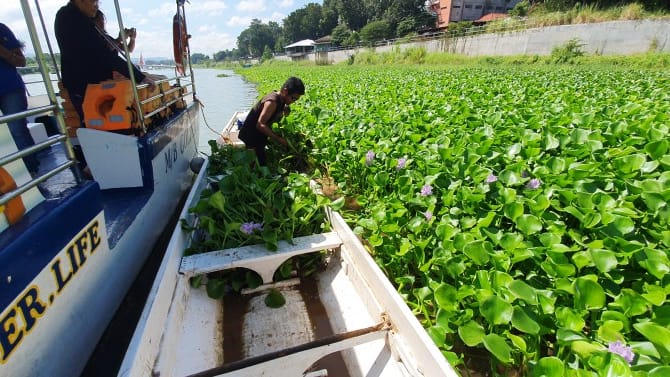
Manila, Jan.
24 -- A nonprofit foundation here has warned that the unabated growth of water hyacinths in the Cagayan River would worsen future flooding.
Dr.
Rosalina Huerbana, president of Safer River, Life Saver Foundation Inc.
(SRLSF), said Thursday eradication remains the best solution to rid the river of the free-floating perennial aquatic plant.
Huerbana said SRLSF has been manually removing water hyacinths on a daily basis but conceded that the cleanup requires machinery and support from the local government.
"We need machines to speed up the process, but it's so expensive.
This is why the workers do it manually," she said, pointing out that several local governments in Metro Manila use conveyor-type machines to clean the Pasig River.
In an earlier statement, the City Local Environment Office chief Armen Cuenca said they share the apprehension over the exponential growth of the aquatic weed plant on the river.
However, Cuenca said the local government would want to "regulate" the growth of the water hyacinths rather than weeding it out completely.
Cuenca said the aquatic plant can absorb toxic chemicals and heavy metals and could also be used as rich source for fiber for ropes and textile production.
"There are already studies that would say that water hyacinths can be used in treating water as natural filters," he said.
Livelihood use Huerbana agreed with Cuenca, saying the regulation of water hyacinth growth to optimal levels would still need machinery--both for harvesting the plant and to process it into raw fiber.
She said the Villar Foundation, a livelihood organization founded by Senator Cynthia Villar and her husband, former Senator Manuel Villar, popularized the use of water hyacinths to help small businesses turn the raw material into handicrafts and other products.
"You can see how their organization made gowns, bags, and handicrafts from those fibers.
They said they are willing to share their expertise to teach us here," she said.
Huerbana said turning the river's massic population of water hyacinths into a commercial venture would need the cooperation of the private sector and the government.
Alfonso Alamban, director of the Department of Science and Technology in Region-10 (DOST-10), earlier said water hyacinths have been a source of livelihood for a number of residents in Bukidnon and Cotabato provinces.
Virgilio Fuertes, DOST provincial director in Bukidnon, said the machine needed to convert the aquatic plan into use fiber is relatively cheaper depending on the desired product outcomes.
Fuertes said DOST is open to conduct free technical assistance to any group planning to come up with a livelihood project involving water hyacinth fiber production.
"It's been long existing (the fiber machine), especially in Luzon.
The Villars already made good projects out of it, so any group can also ask assistance from Senator Villar for the (procurement of) the equipment," he said.